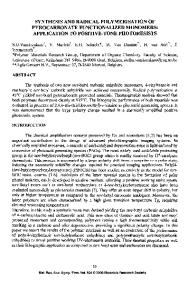Transition metal-catalyzed polymerization of polar allyl and diallyl monomers
- PDF / 495,030 Bytes
- 8 Pages / 585 x 783 pts Page_size
- 86 Downloads / 312 Views
Introduction Transition metal-catalyzed homopolymerization of polar vinyl monomers, especially acrylate and methacrylates, has been extensively studied (Scheme 1a).1,2 Ziegler-Natta catalysts such as TiCl4/AlR3 (R = alkyl group) have been known to promote polymerization of polar monomers such as methyl methacrylate (MMA). Homogeneous catalysts (catalysts soluble in reaction solvents such as zirconocenes and lanthanocenes) are effective for stereospecific polymerization of methacrylates.1,2 C 2-symmetric zirconocenes (zirconocenes with two-fold symmetry) and Cs-symmetric zirconocenes (zirconocenes with a plane of symmetry) bring about isospecific (the ester side chains are located on the same side of the macromolecular backbone) and syndiospecific (the ester side chains are located on alternating sides along the macromolecular backbone) polymerization of MMA, respectively. Because the early transition metal catalysts show catalytic activity for polymerization of both ethylene or α-olefin and MMA, one would expect that the polymerization of ethylene or α-olefin in the presence of MMA by the catalysts would afford the polymer containing the repeat units from both monomers (copolymerization). Polyethylene or polyolefins having polar functional groups have been known to show improved adhesionability, dyeability, and compatibility. Compared to the homopolymerization of polar vinyl monomers, however, copolymerization of the polar vinyl monomers with
ethylene or α-olefins is more challenging and less explored (Scheme 1b).3–7 One of the reasons for the difficulty in the copolymerization is that the early transition metal, the active center of the catalyst, tends to form a strong bond with the oxygen atom (oxophilic character). The addition of polar vinyl monomers often retards the smooth reaction of ethylene and α-olefins. Another reason is the difference in active species of the polymerization: Polymerization of ethylene and α-olefins proceeds via metal-alkyl species, whereas the polymerization of acrylates and methacrylates generally proceeds via metalenolate species. Metal-alkyl species often allow insertion of acrylates and methacrylates, but insertion of ethylene and α-olefins to metal-enolate is generally much more difficult. The polymerization by less oxophilic late transition metal catalysts, especially Pd catalysts, enables copolymerization of those monomers. α-Olefins with a polar functional group in the ω-terminal have been frequently utilized as the comonomer for copolymerization with ethylene or other α-olefins (Scheme 1c).3,4 They do not retard the smooth chain growth, and the polar functional group of the monomer is incorporated on the terminal of the side chains in the produced copolymer. Allyl monomers such as allyl alcohol and allyl halides are also attractive monomers for transition metal-catalyzed polymerization and copolymerization. Copolymerization of ethylene or α-olefins with allyl monomers would afford the copolymer having the functional group in
Daisuke Takeuchi, Chemical Resources Laboratory, Tokyo Institute o
Data Loading...











